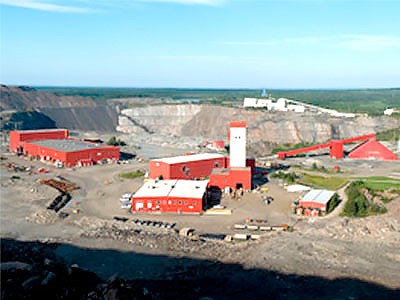With its ore reserves depleting, it was inevitable that the closing of Goldcorp’s Dome underground mine would come sooner rather than later. But a constant decrease in gold prices over the last year was the final blow for the 106-year-old mine.
Goldcorp announced Jan. 14 that Dome underground would cease operations by the middle of 2016. It’s the last of the “big three” gold mines — Hollinger, McIntyre and Dome — that made Timmins one of the world’s most prolific mining camps and helped put the city on the map.
In 1909, Dome was the first of the big three to be discovered, during an expedition led by Jack Wilson. Production started in 1910 and Dome produced continuously until 2004 when the mine was put on care and maintenance. Production resumed in 2006.
It is the country’s oldest and longest producing mine. And one of the most prolific.
Early in 2015, Brendan Zuidema, general manager of Porcupine Gold Mines, was quoted saying there was an estimated five years’ worth of ore left in the ground. What a difference a year makes.
“One of the big drivers, obviously, is the gold price,” he said.
“A year ago, when we were looking at things, the gold price was still around US$1,500, so it was still up there a little bit. But with the gold price down around $1,100 and approaching $1,000 an ounce, that’s one of the big drivers.”
But aside from that, the mine is old and, along with it, its infrastructure. Operating costs for the mine are around the same cost of the gold being extracted, putting Goldcorp in a break-even situation and making it harder for the mine to be profitable, Zuidema said.
Rather than put Dome on care and maintenance to see if prices improve, the company is looking forward, assessing the potential in using the underground mine for its tailings, something that is still in the permitting phase and awaiting Ministry of Environment and Climate Change approval.
“On the big picture side, there’s some big, big potential savings there if we can put tailings underground here and in the pit, versus putting them in our tailings pond,” he said.
The company has pinpointed July 31 as its production end date, although mining activities could cease before then — it depends on the next five months.
“As long as we can make safe, efficient production until then, we’ll keep it going, and then at that point we kind of run out, because we’re stopping development,” Zuidema said.
Closure of the mine will directly affect 115 company employees and 76 contractors, but the impact is expected to be even more far-reaching.
Because the mine has a unionized workforce, senior workers will be able to “bump” others from their current positions, he said.
When Goldcorp closed the Pamour open-pit mine in 2011, workers were transferred to the Dome pit operation because of their experience working an open-pit mine. Now that Dome is closing, those same workers could be transferred to the Hollinger pit, bumping some of the newest Goldcorp workers to be hired, Zuidema estimated.
Still, there may be an opportunity to save some jobs. Zuidema said there are positions open at Hoyle Pond, and trades workers could even find work at one of Goldcorp’s other properties at Red Lake, Musselwhite, or Éléonore in Quebec.
The company is additionally enlisting the assistance of community programs that will help support employees as they make the transition, he noted.
Goldcorp is in the process of establishing a timeline for decommissioning, but Zuidema said some work could start in 2016 and will likely take a few years.
“There’s still lots of infrastructure here that’s not associated with the Dome mine itself,” he said.
“But the few buildings here that are associated with the Dome, we’ll be looking at decommissioning them and taking them down and look at the assets in there that we might be able to move elsewhere — hoists and stuff like that.”
Even though the community knew the closure was coming, Zuidema said it’s still been an emotional time.
“We’ve got fourth and fifth generation people working here at the Dome,” he said. “It’s been part of the community for a long time.”




